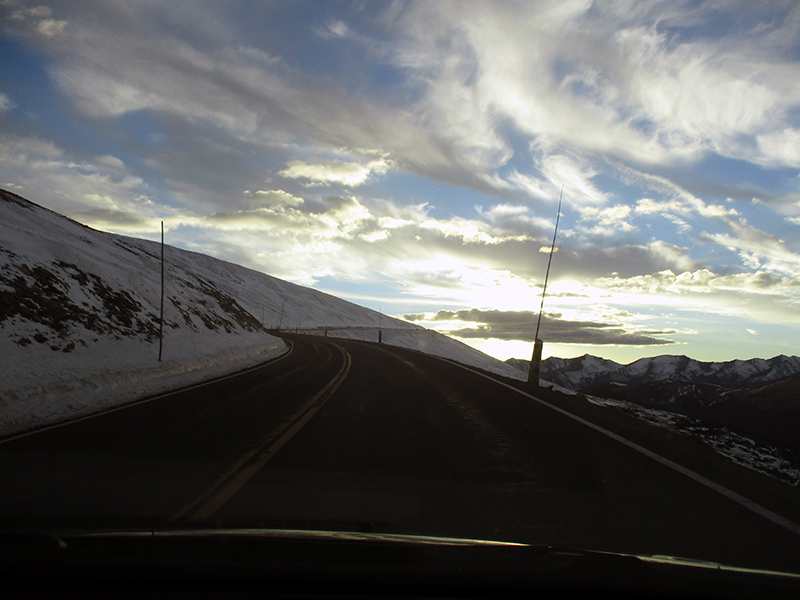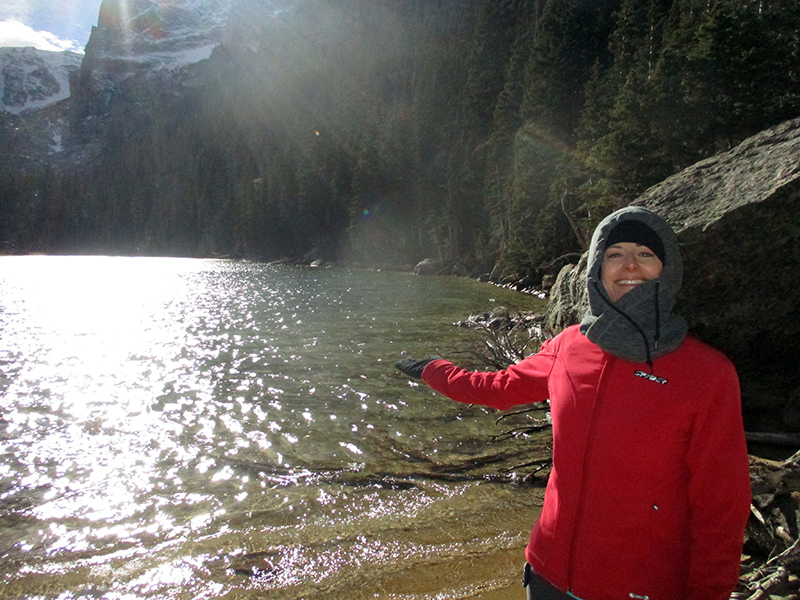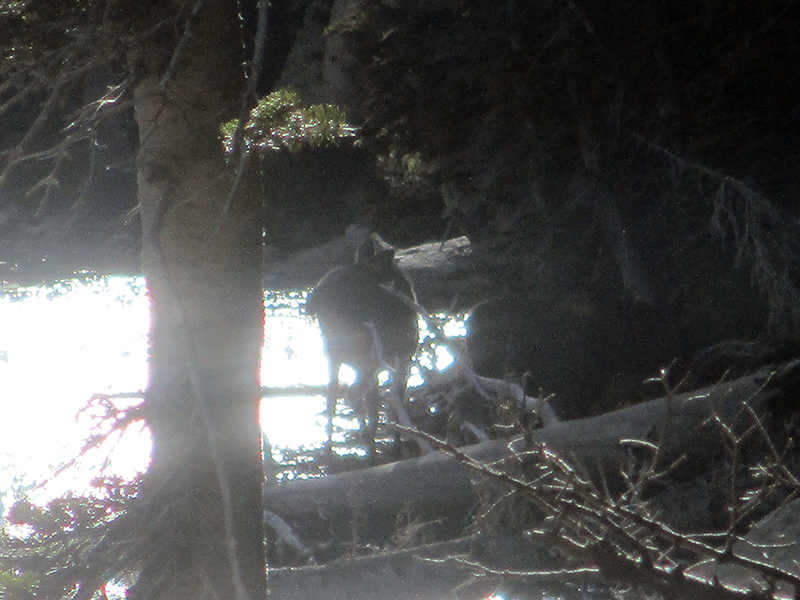 We only had four days to explore Rocky Mountain National Park — barely long enough to see just a few highlights of this 415-square-mile, high-altitude wonderland in northern Colorado. Our long, 10-hour drive to get there from Black Canyon of the Gunnison took us up and down over countless mountain passes, but the most forbidding mountain pass came in the park itself.
We only had four days to explore Rocky Mountain National Park — barely long enough to see just a few highlights of this 415-square-mile, high-altitude wonderland in northern Colorado. Our long, 10-hour drive to get there from Black Canyon of the Gunnison took us up and down over countless mountain passes, but the most forbidding mountain pass came in the park itself.
 We entered the park from the west side near Grand Lake, but because more infrastructure and hiking trails are located on the east side near Estes Park, we wanted to cut through the heart of the park up and over the spine of the Rocky Mountains using Trail Ridge Road. The highest-elevation continuously paved road in the country, Trail Ridge Road tops out at more than 12,000 feet, and often by November (when we visited) snow and ice force its closure until late May. We stopped in at the Kawuneeche Visitor Center to get a brief overview of the park and trail recommendations and check the road status. Happily, the road was open but the ranger said we should exercise caution in the 11-mile stretch above the tree line with no guardrails. That made me rather nervous.
We entered the park from the west side near Grand Lake, but because more infrastructure and hiking trails are located on the east side near Estes Park, we wanted to cut through the heart of the park up and over the spine of the Rocky Mountains using Trail Ridge Road. The highest-elevation continuously paved road in the country, Trail Ridge Road tops out at more than 12,000 feet, and often by November (when we visited) snow and ice force its closure until late May. We stopped in at the Kawuneeche Visitor Center to get a brief overview of the park and trail recommendations and check the road status. Happily, the road was open but the ranger said we should exercise caution in the 11-mile stretch above the tree line with no guardrails. That made me rather nervous.
 Trail Ridge Road began disarmingly enough through forests and meadows with the meandering Colorado River off to one side. It is in Rocky Mountain National Park that the mighty river begins its 1,450-mile journey, but with waning daylight, the river is one of the highlights we did not have time to stop and explore. The higher we climbed on Trail Ridge Road, the more unsettling it became.
Trail Ridge Road began disarmingly enough through forests and meadows with the meandering Colorado River off to one side. It is in Rocky Mountain National Park that the mighty river begins its 1,450-mile journey, but with waning daylight, the river is one of the highlights we did not have time to stop and explore. The higher we climbed on Trail Ridge Road, the more unsettling it became.
 Approaching the Alpine Visitor Center just before the highest point in the road, we were on the outside lane and so high up that from my driver’s side I could see nothing but air off to the right side. Hector found the mountain scenery some of the most magnificent he’d ever seen while I tried to focus on the road and take deep breaths. My muscles tensed and I feared we’d go flying right off the mountainside as my nervousness morphed into near-panic. By the time we reached the Gore Range lookout I had to pull over, get out of the car and ask Hector to drive.
Approaching the Alpine Visitor Center just before the highest point in the road, we were on the outside lane and so high up that from my driver’s side I could see nothing but air off to the right side. Hector found the mountain scenery some of the most magnificent he’d ever seen while I tried to focus on the road and take deep breaths. My muscles tensed and I feared we’d go flying right off the mountainside as my nervousness morphed into near-panic. By the time we reached the Gore Range lookout I had to pull over, get out of the car and ask Hector to drive.
 Back in the car, I had to close my eyes until we descended to the Rock Cut overlook and parking lot for the Tundra Communities Trailhead. My nerves were still frayed as we hiked up the trail a short distance, and only the sight of a herd of elk calmly grazing on the tundra brought my heart rate back to normal.
Back in the car, I had to close my eyes until we descended to the Rock Cut overlook and parking lot for the Tundra Communities Trailhead. My nerves were still frayed as we hiked up the trail a short distance, and only the sight of a herd of elk calmly grazing on the tundra brought my heart rate back to normal.
Gradually we descended to where visible rolling tundra at the roadside replaced the sheer drop-off, and the tree line reappeared. By then dusk had arrived, so Hector proceeded cautiously and watched for deer and elk by the side of the road. When we pulled into our motel in Estes Park well after nightfall, I was utterly spent.
 We spent the next day in the Fall River area of the park. We first hiked a short stretch on Old River Road up to Chasm Falls. During summer this gravel road is open to cars for one-way traffic going uphill and reportedly rivals Trail Ridge Road as a scary drive, but after summer only hikers and cyclists have access. The falls were rather ho-hum, especially after the impressive waterfalls in Yosemite, so we moved on to our next destination — the Beaver Mountain Loop.
We spent the next day in the Fall River area of the park. We first hiked a short stretch on Old River Road up to Chasm Falls. During summer this gravel road is open to cars for one-way traffic going uphill and reportedly rivals Trail Ridge Road as a scary drive, but after summer only hikers and cyclists have access. The falls were rather ho-hum, especially after the impressive waterfalls in Yosemite, so we moved on to our next destination — the Beaver Mountain Loop.
 The trail descended from Deer Ridge Junction into Beaver Meadow. From there it climbed the east side of Beaver Mountain before descending once again into the lower part of the meadow looking down toward Moraine Park. We enjoyed the hike, but trail signage didn’t seem to match our map, leaving us confused and hiking more than the seven miles we had intended to do. A little extra exercise never hurts, though, and as a bonus we came across a herd of 100+ elk.
The trail descended from Deer Ridge Junction into Beaver Meadow. From there it climbed the east side of Beaver Mountain before descending once again into the lower part of the meadow looking down toward Moraine Park. We enjoyed the hike, but trail signage didn’t seem to match our map, leaving us confused and hiking more than the seven miles we had intended to do. A little extra exercise never hurts, though, and as a bonus we came across a herd of 100+ elk.
 Hunting had wiped out native elk from the area by 1900, but in 1913-14 the U.S. Forest Service reintroduced a small herd from Yellowstone National Park. Since then they’ve multiplied so successfully that they sometimes exceed the park’s estimated carrying capacity of 600-800 animals, at which point they can damage willow, aspen and other vegetation. Fencing around sensitive habitat areas keeps these voracious browsers from wreaking too much havoc.
Hunting had wiped out native elk from the area by 1900, but in 1913-14 the U.S. Forest Service reintroduced a small herd from Yellowstone National Park. Since then they’ve multiplied so successfully that they sometimes exceed the park’s estimated carrying capacity of 600-800 animals, at which point they can damage willow, aspen and other vegetation. Fencing around sensitive habitat areas keeps these voracious browsers from wreaking too much havoc.
 The elk travel outside the park as well and tromp through the town of Estes Park. In the fall rut they cause traffic jams as motorists stop to let the enormous beasts cross the road or photograph them browsing their way through residents’ back yards.
The elk travel outside the park as well and tromp through the town of Estes Park. In the fall rut they cause traffic jams as motorists stop to let the enormous beasts cross the road or photograph them browsing their way through residents’ back yards.
 The next day we got an early start to grab a spot at one of Bear Lake Road’s parking lots, which can fill up by mid-morning on autumn weekends. From the Glacier Gorge Trailhead we hiked to Alberta Falls and continued uphill to The Loch.
The next day we got an early start to grab a spot at one of Bear Lake Road’s parking lots, which can fill up by mid-morning on autumn weekends. From the Glacier Gorge Trailhead we hiked to Alberta Falls and continued uphill to The Loch.
 Here we encountered the Rockies at their most quintessential. Snow clouds moved across the sky and a bitter, cold wind blew in our faces. As the snow began to fall, we continued past the highly scenic and mostly ice-covered Loch at the base of bold mountain slopes.
Here we encountered the Rockies at their most quintessential. Snow clouds moved across the sky and a bitter, cold wind blew in our faces. As the snow began to fall, we continued past the highly scenic and mostly ice-covered Loch at the base of bold mountain slopes.
 The trail grew icier as we trudged uphill toward Sky Pond, a sub-alpine lake at nearly 11,000 feet. Without crampons, however, we turned around before reaching Sky Pond because the trail got too slick. On the way down, Hector slipped and fell, bruising his pride and bending one trekking pole beyond repair.
The trail grew icier as we trudged uphill toward Sky Pond, a sub-alpine lake at nearly 11,000 feet. Without crampons, however, we turned around before reaching Sky Pond because the trail got too slick. On the way down, Hector slipped and fell, bruising his pride and bending one trekking pole beyond repair.
 Luckily the next day’s hike was less treacherous, so he could get by with just one trekking pole. Past Moraine Park, we took the Fern Lake Trail that started with a gentle uphill traverse along the Big Thompson River through a forest of aspen, lodgepole and ponderosa pine, cottonwood and willow. We soon crossed a footbridge at The Pool, where the trail then followed Fern Creek.
Luckily the next day’s hike was less treacherous, so he could get by with just one trekking pole. Past Moraine Park, we took the Fern Lake Trail that started with a gentle uphill traverse along the Big Thompson River through a forest of aspen, lodgepole and ponderosa pine, cottonwood and willow. We soon crossed a footbridge at The Pool, where the trail then followed Fern Creek.
 We continued up to Fern Falls and had a steep onward climb to Fern Lake, part of whose surface sported a thin film of ice. We passed a ranger patrol hut and circled the lake, then came to a higher section of creek fringed with ice. A frigid wind blew down from Odessa Lake above the stream but we pushed on.
We continued up to Fern Falls and had a steep onward climb to Fern Lake, part of whose surface sported a thin film of ice. We passed a ranger patrol hut and circled the lake, then came to a higher section of creek fringed with ice. A frigid wind blew down from Odessa Lake above the stream but we pushed on.
 The sandy beach on the near edge of Odessa Lake was so wind-whipped that we had to take shelter behind a large boulder to eat our lunch. We then snapped a few photos before heading back downhill, and that’s when Hector noticed something across the lake about 150 yards away. “What the heck is that?” he exclaimed.
The sandy beach on the near edge of Odessa Lake was so wind-whipped that we had to take shelter behind a large boulder to eat our lunch. We then snapped a few photos before heading back downhill, and that’s when Hector noticed something across the lake about 150 yards away. “What the heck is that?” he exclaimed.
 The sun glittering on the water’s surface made it hard to see (and even more difficult to photograph), but we spied two very large, dark creatures standing at the edge of lake. Their spindly legs, big bodies and bucket noses gave them away unmistakably as moose, even though, as females, they lacked the big Bullwinkle antlers. We had not expected to see moose here; they most often inhabit the Kawuneeche Valley on the park’s west side, wading in the Colorado River’s shallow waters. We were thrilled at the sight of them.
The sun glittering on the water’s surface made it hard to see (and even more difficult to photograph), but we spied two very large, dark creatures standing at the edge of lake. Their spindly legs, big bodies and bucket noses gave them away unmistakably as moose, even though, as females, they lacked the big Bullwinkle antlers. We had not expected to see moose here; they most often inhabit the Kawuneeche Valley on the park’s west side, wading in the Colorado River’s shallow waters. We were thrilled at the sight of them.
 Our final hike was in the remote Wild Basin area in the park’s southeast corner. The ranger had told us that fewer people visit this section of the park, and as we started out we were the only ones on the trail. Our trek followed St. Vrain Creek through montane forest to Copeland Falls.
Our final hike was in the remote Wild Basin area in the park’s southeast corner. The ranger had told us that fewer people visit this section of the park, and as we started out we were the only ones on the trail. Our trek followed St. Vrain Creek through montane forest to Copeland Falls.
 We continued up the trail and over to Calypso Cascades that was half ice and half flowing water, then crossed smaller Ouzel Falls before looping back down past several back-country campgrounds. This warm and pleasant walk through the woods, albeit with fewer dramatic Rocky Mountain views than some of our other hikes, was, sadly, the last highlight we had time for. With more than 350 miles of trails to explore, a brief sampler in Rocky Mountain National Park will never suffice, but it will have to do for now.
We continued up the trail and over to Calypso Cascades that was half ice and half flowing water, then crossed smaller Ouzel Falls before looping back down past several back-country campgrounds. This warm and pleasant walk through the woods, albeit with fewer dramatic Rocky Mountain views than some of our other hikes, was, sadly, the last highlight we had time for. With more than 350 miles of trails to explore, a brief sampler in Rocky Mountain National Park will never suffice, but it will have to do for now.
Hi Christi, I spent 7 days there in the fall last year and its interesting to see what it looks like in the winter, but it certainly was outstanding in Fall. The Loch was pretty, but when you hike up the waterfall to the mirror lake its amazing, never seen anything like it. I can see why Hector fell its a bit slippery on that trail and wet! I agree that trail ridge is pretty frightening drive but great to hike around up there.
Too bad we left our crampons in the car – it sounds like we missed a lot by turning around before reachinng Sky Pond. Glad you got to see more of the park than we did.
Too bad Hector broke one of his hiking sticks and to top that off he busted his bum. I can imagine how you must have felt driving that Trail Ridge Road, thankfully Hector took over and braved it to the end.The Fern Lake photo was so picturesque. Colorado is so beautiful, I could live there in a cabin in the woods . . . with snow of course.
Onward!
Colorado is breathtaking. I’d live there, too, if I could handle the cold. Alas, even sunny Arizona is almost too cold for me in the winter.